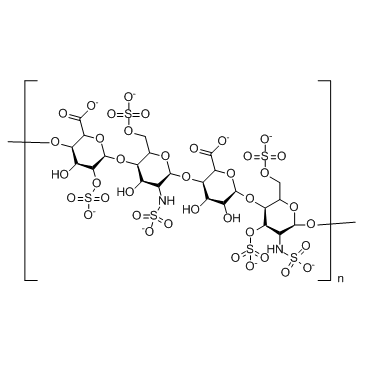Heparan Sulfate
Modify Date: 2025-08-25 06:52:49

Heparan Sulfate structure
|
Common Name | Heparan Sulfate | ||
|---|---|---|---|---|
| CAS Number | 9050-30-0 | Molecular Weight | 593.47 (monomer) | |
| Density | N/A | Boiling Point | N/A | |
| Molecular Formula | C12H19NO20S3(monomer) | Melting Point | N/A | |
| MSDS | N/A | Flash Point | N/A | |
Use of Heparan SulfateHeparan sulfate, a complex and linear polysaccharide, exists as part of glycoproteins named heparan sulfate proteoglycans, which are expressed abundantly on the cell surface and in the extracellular matrix. |
| Name | heparan sulfate |
|---|
| Description | Heparan sulfate, a complex and linear polysaccharide, exists as part of glycoproteins named heparan sulfate proteoglycans, which are expressed abundantly on the cell surface and in the extracellular matrix. |
|---|---|
| Related Catalog | |
| In Vitro | Heparan sulfate is a linear polysaccharide and belongs to the family of glycosaminoglycans. Heparan sulfate is composed of glucuronic acid (GlcA) and iduronic acid (IdoA) residues as well as N-acetyl glucosamines (GlcNAc) with various sulfation modifications, and is typically 50-200 disaccharides in length. Heparan sulfate interacts with numerous proteins, including growth factors, morphogens, and adhesion molecules, and thereby regulates important developmental processes in invertebrates and vertebrates. Heparan sulfate chains regulate developmental signaling by acting as co-factors through a variety of mechanisms that include but are not limited to maintenance of morphogen gradients and co-receptor functions[1]. Heparan sulfate proteoglycans can act as receptors for proteases and protease inhibitors regulating their spatial distribution and activity. Membrane Heparan sulfate proteoglycans act as coreceptors for various tyrosine kinase-type growth factor receptors, lowering their activation threshold or changing the duration of signaling reactions[2]. Heparan sulfate influences the binding affinity of intestinal epithelium cells to Wnt, thereby promoting activation of canonical Wnt signaling and facilitating regeneration of small intestinal crypts after epithelial injury[3]. |
| In Vivo | Digestion of heparan sulfate impairs context discrimination in a fear conditioning paradigm and oscillatory network activity in the low theta band after fear conditioning. Thus, heparan sulfate maintains neuronal excitability and, as a consequence, support synaptic plasticity and learning[4]. FGF-2/FGFR system is involved in the regulation of astrocytic reactivity and/or proliferation in the brain and its action is potentiated by heparan sulfate[5]. |
| Animal Admin | Rats: Sprague-Dawley male rats 3-4 months old receive aspiration of a small segment of the motor-sensory cortex in both hemispheres. Groups of rats (n=5) receive a piece of Gelfoam embedded with human recombinant FGF-2, heparan sulfate (10 kg/mL; sodium salt, bovine kidney) dissolved in PBS, or both, in the right hemisphere. The wound cavity of the left hemisphere receives a piece of Gelfoam embedded with saline[5]. |
| Molecular Formula | C12H19NO20S3(monomer) |
|---|---|
| Molecular Weight | 593.47 (monomer) |
| PSA | 342.65000 |
| Storage condition | 2-8℃ |